Andrew Hasegawa recently wrote about Dianne Jackson where he referenced a Sunday Herald Sun Weekend Magazine article entitled “Where Are They Now?” published on 10 December 1983. The article tells a story of love, marriage and separation of an Australian woman from Geelong, Ada May Furuya, and Japanese man, Haruhiko Shibuya from Kobe, in Japan. Haruhiko Shibuya was my father.
Ada May was the eldest stepdaughter of George Taro Furuya who was the son of an American seaman and Japanese woman. He was adopted and brought up by the Furuyas in Japan and later still quite young was employed by the Mitsui Company as a shipping clerk. He left Japan at the age of 17 and eventually made his way to the USA where he worked for some years. He arrived in Australia in 1901 and married Ada May’s mother and settled down in Geelong. He ran a laundry shop as well as a ship supply business. Haruhiko arrived in Geelong as the Second Officer of the merchant ship, Taishou Maru, during the First World War. Haruhiko and Ada May fell in love with each other.
Ada May and Haruhiko, who by the war’s end was a sea captain, married in Kobe in 1919. They had a daughter in 1920 and a son two years later.
Ada May came back to Geelong with her two-year old daughter and baby son. According to Ada May’s daughter Hannah Matuschik (my half-sister), Ada May’s ill health was partly her reason for returning to Australia. While Haruhiko was absent from home on a two-year merchant ship voyage, Ada May developed asthmatic symptoms which she suffered from for the rest of her life. Haruhiko failed to join his wife and children in Australia and went to Europe instead. Later, Ada May moved to Sydney with her two children. She made a family with Sakuhei Suzuki, with whom she had three children.
Much later Haruhiko also remarried in Japan to my mother. The article of Herald Sun reports on my Australian Connection and my half-sister and half-brother I had not met. After my mother’s death six year earlier, I became more interested in my connection with Australia. However, I was reluctant to reveal my father’s story to a stranger. Then, I met the Tokyo corespondent for the Melbourne-based Herald and Weekly Times, Ian MacArthur, through my relatives at a new year family gathering in 1983. I still recall Ian’s surprise when I told him of my father’s story and his connection with Australia. Family connections between Australia and Japan were comparatively rare at that time.
……………….
One year after the publication of the article in December 1984, I met my half-sister and half-brother, Hannah Matuschik and Joseph (Joe) Stacy, for the first time. Hannah, Joe and Hannah’s son Peter welcomed me at the International Airport in Adelaide. Peter kindly offered me accommodation and from then on, I stayed with Peter and his wife, Jennie, during my occasional visits to Adelaide.
Hannah told me that one of the twin granddaughters of George Taro Furuya rang her and told her about the Herald Sun article. The news was very much a surprise to Hannah and Joe because they believed their biological father had died young. Hannah said in astonishment to me: “Not dead. He even remarried, then left a daughter!” I spent some dream-like days with Hannah and Joe during Christmas and the New Year season of 1984.
I learned a year later that my arrival in Australia was disturbing for Ada May’s son and grandson on the Suzuki’s side. I suppose it is quite common that there are some tensions among family members regarding the origins of the family, especially in a family consisting of two marriages like the family of Ada May and Suzuki. Within family history, the name of Haruhiko Shibuya may have brought quite different images and meanings. While Hannah and Joe could idealise the sea captain Haruhiko Shibuya who was thought to have died young, for Suzuki and his grown-up sons, Haruhiko and his family were cruel people who sent Ada May back to Australia with two young children (a toddler and a six-month old baby). My arrival may have changed the family, bringing forth Haruhiko as a real person who survived for decades after their separation. It could surface tensions that had gone unmentioned for some time.
Needless to say, Australian citizens with Japanese backgrounds had a difficult time during the second world war and subsequent decades of the post war period. George Taro Furuya, Suzuki Sakuhei, Hannah and Joe, having been born in Japan, were all interned as enemy aliens during the war. Furthermore, wartime propaganda along with Japanese treatment of Australian prisoners of war saw widespread hatred towards the Japanese well into the postwar period in Australia. In order to cope with such denial of Japan and Japanese identity, descendants of the Furuyas and Suzukis changed their family names. Although it is said that changing surnames in Australia is a much more acceptable social practice compared with countries like Japan, there must be a degree of pain and anxiety in reaching that decision.
Hannah passed away in 2004. At the very end of her life I spent a whole day beside her in the hospital. We had a chat about her mother, Ada May. I am thankful to Peter for arranging this. My then partner Gary and I attended Hannah’s funeral.
The following year, I suddenly received an email from Jodie Williams who is a fifth-generation descendant of George Taro Furuya. She got my name from the Sunday Herald piece kept by Jodie’s great-great grandaunt June. She found me living in Australia and wrote that this was an utter surprise for her. We communicated and I learnt of her fascination with horses since she was four years old. When she left school, she joined the Defence Force where she and her peers became the first female personnel who reached the rank of corporal. She has since left the Army, and started a firm with her husband located quite far away from her origins in Geelong.
Jodie wanted to make a family tree for her newborn son. I suggested writing to Joe who was very alert in recalling the past and her contact with Joe made him very happy. He rang me about photos sent by her.
Joe Stacy passed away in 2015. At his funeral, I met Cherie Montgomery who was one of Joe’s nieces from Ada May’s second marriage. I met a descendant of Suzuki Sakuhei for the first time.
The small piece in the Herald Sun published over 35 years ago was still having its effect until very recently. Deb Freer, the great granddaughter of George Taro Furuya, and her step sister Donna Holmes, were trying to piece together materials left by George Taro Furuya and reconstruct his life story. Donna emailed me in 2019. It sounds like a fascinating project. Moreover, Deb’s son and daughter have a keen interest in the culture of Japan and Korea. Deb’s daughter graduated from Queensland University with Korean Studies. One of Deb’s grandchildren was called “Ryoko” which is, I think, a Japanese name. (My eldest cousin had the same name.). Those from the younger generation will tell fertile stories of cross-cultural connection sometime soon.
The former journalist, Ian MacArthur, who wrote the article for the Herald Sun is currently working on a book project about the well-known First Nation historical figure, Bennelong, who Governor Phillip took to London where he lived for a short while (1793-94).
I like to think of how this newspaper article was kept and passed on to the younger generation of the family and the role it played in connecting me and descendants of Furuya.
Finally, I should mention what happened to my father, Haruhiko Shibuya. He returned to the sea as the sea captain when the Second World War broke out. He survived the war until July 1945. At the end of the war, he was in a port in North Korea. He sent his crew home but then failed to return home himself. Our family register recorded him as killed in action in Chingjin in North Korea in 1945, which was approved by the Governor of City Tokyo in 1953.
My mother was one of number of families of unreturned soldiers, who accepted their death in order to apply for bereaved family pension benefit enacted in 1953. Shortly before her own death, she once mentioned her husband, Haruhiko. “I could not get to know at last how he died.”
(Thanks to Gary Pearce for proof reading assistance with this paper.)
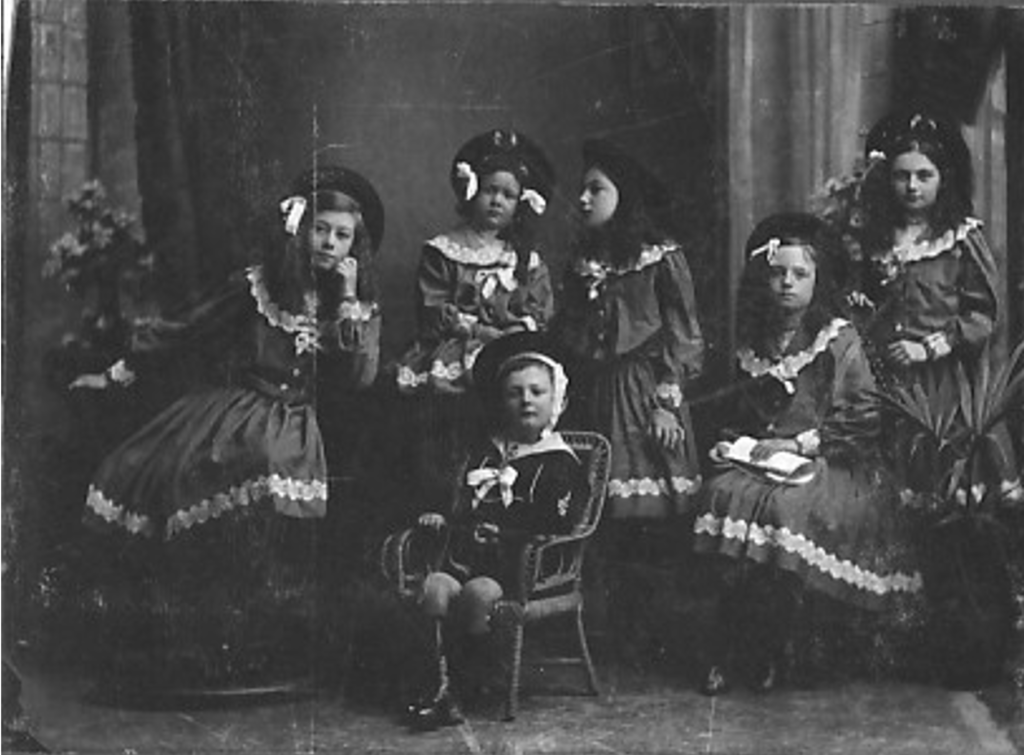
Furuyas in Geelong, 1912 フルヤ家 1912
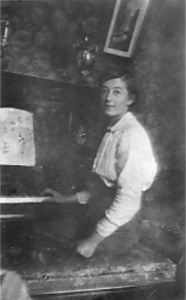
Aida May Furuya エイダ・メイ・フルヤ
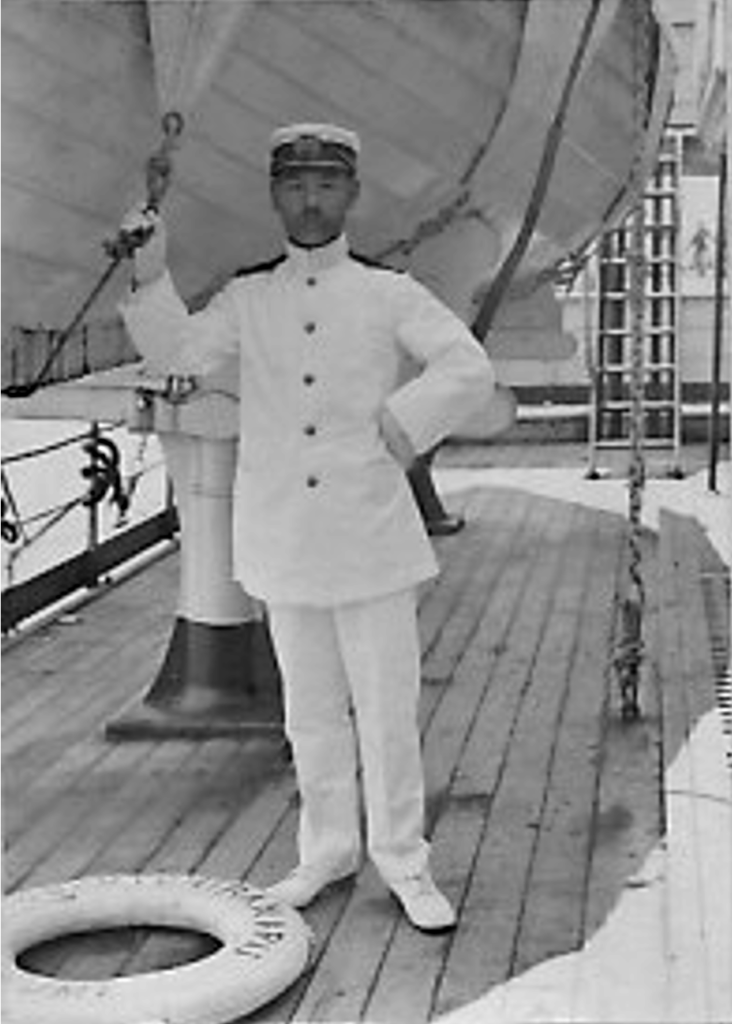
Haruhiko the sea captain, 1917 船長治彦 1917
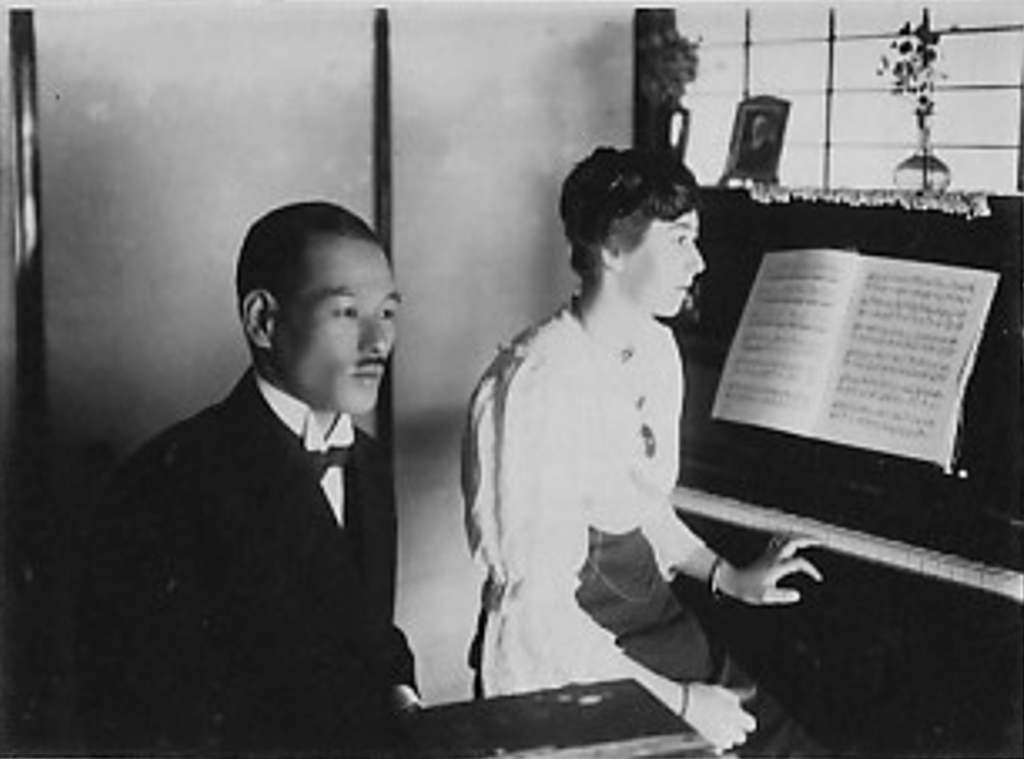
Marriage in Japan 日本での結婚
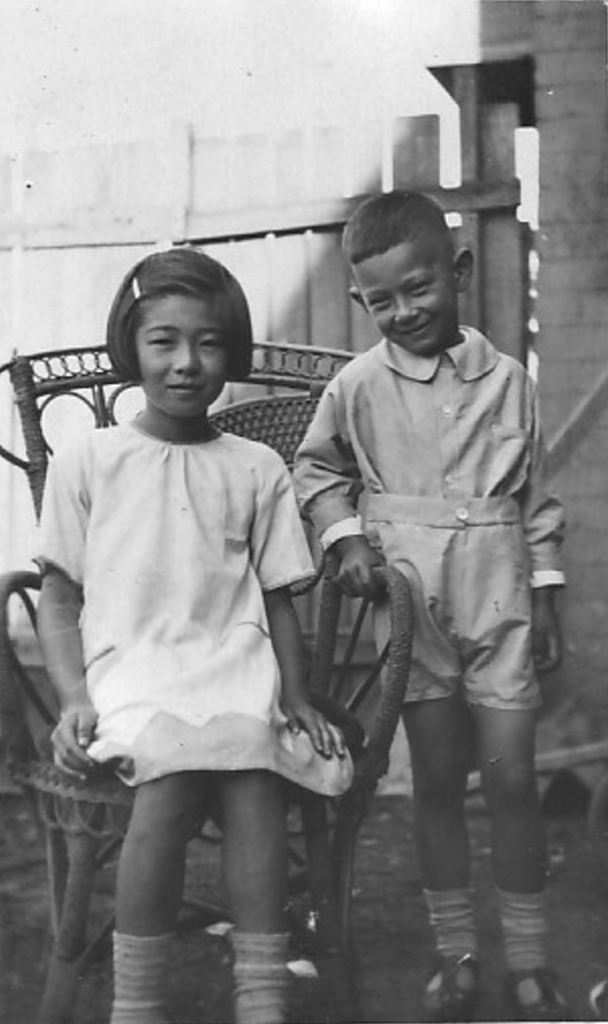
Hannah and Joe Growing up in Sydney ハンナとジョー、シドニーで育つ
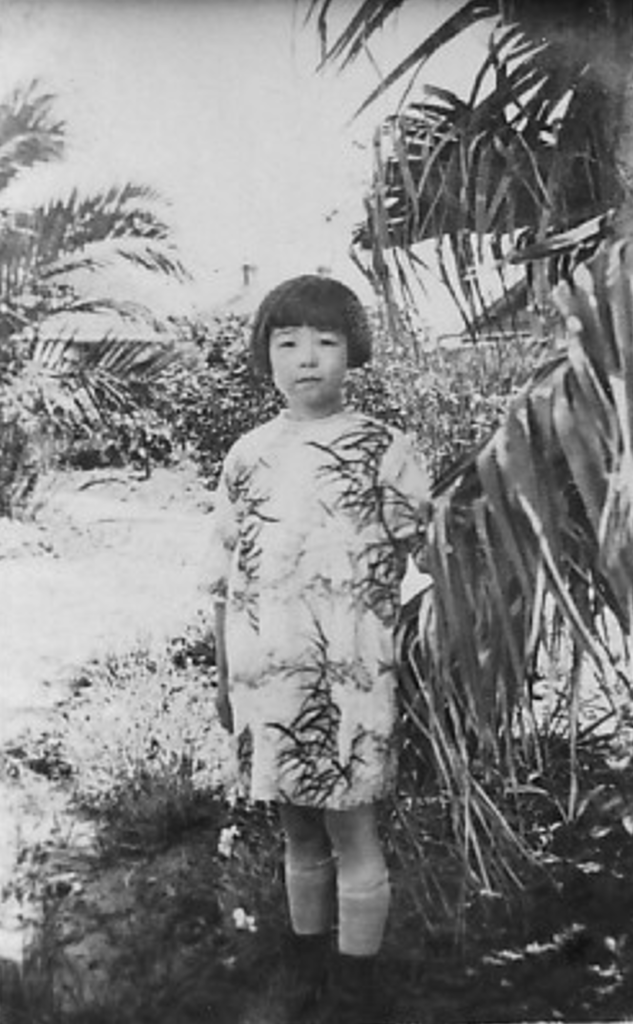
Hannah ハンナ

Haruhiko’s second family and baby Iwane, 1945 治彦の新しい家族とベビーいはね1945年
アンドリュー・ハセガワ氏が先日、ダイアン・ジャクソン氏について書いた文章の中で、「Where Are They Now?(彼らは今どこに?)」という日曜紙ヘラルドサンの記事を紹介した。この記事は1983年12月10日付の同紙でライフスタイル情報の別冊ウィークエンド・マガジンに掲載されたものだ。この記事では、ジーロング出身のオーストラリア人女性エイダ・メイ・フルヤ(Ada May Furuya)と、神戸出身の日本人男性、渋谷治彦の間での愛と結婚、そして別れが描かれている。―― 渋谷治彦は私の父だ。
エイダ・メイは、ジョージ・タロウ・フルヤの最年長の義理の娘だった。ジョージ・タロウ・フルヤは米国人船員と日本人女性の間に生まれ、古谷家の養子として日本で育ち、若くして三井物産に積荷事務員として雇われた。17歳で日本を離れ、最終的に米国に渡り数年働いた。1901年にオーストラリアに到着したジョージ・タロウ・フルヤは、エイダ・メイの母親と結婚し、ジーロングに定住した。彼は洗濯屋と船用品店を営んだ。そして第一次世界大戦中、商船「大正丸」の二等航海士として渋谷治彦(シブヤ ハルヒコ)がジーロングにやってきた。治彦(ハルヒコ)とエイダ・メイはそこで互いに恋に落ちた。
終戦時には船長になっていた治彦は1919年に、エイダ・メイと神戸で結婚した。翌年の1920年に娘が、その2年後には息子がそれぞれ誕生した。
エイダ・メイは、2歳の娘と赤ん坊の息子を連れてジーロングに戻ってきた。エイダ・メイの娘で私の異母姉にあたるハンナ・マトシックによると、エイダ・メイがオーストラリアに戻ってきた理由には、体調不良もあったという。2年間にわたる商船航海で治彦が家を留守にしている間に、エイダ・メイは喘息の症状を発症し、それが彼女を一生悩ますことになった。治彦はオーストラリアで妻子と合流することができず、代わりに欧州に渡った。その後、エイダ・メイは2人の子供を連れてシドニーに移り、そこで鈴木作平との間にさらに3人の子供をもうけ、作平との家庭を築いていった。
それからかなり後に、治彦は日本で私の母と再婚した。ヘラルドサンの記事では、私とオーストラリアとのつながりや、私の見知らぬ異母姉兄のことが紹介されている。母が6年前に他界してからは、私は自分とオーストラリアとのつながりにより興味を持つようになった。しかし、自分の知らない人に父・治彦の話をすることに抵抗があった。そんな折、1983年の正月の家族の集まりで、親戚を介してオーストラリアのメルボルンを基盤としているヘラルドとウイークリータイムズの東京特派員であるイアン・マッカーサーと出会った。自分の父の話と、父とオーストラリアとのつながりをイアンに話したときの彼の驚きようは、今でもよく覚えている。当時、オーストラリアと日本との家族のつながりは比較的珍しかった。
……………….
サンヘラルドの記事から1年後の1984年12月、私は異母姉兄であるハンナ・マトシックとジョセフ(ジョー)・ステイシーに初めて会った。ハンナとジョー、そしてハンナの息子のピーターがアデレードの国際空港で私を出迎えてくれた。ピーターは親切にも私に宿泊場所を提供してくれ、それ以来、アデレードを訪れる折には、ピーターと彼の妻ジェニーの家に滞在することになった。
ハンナは、ジョージ・タロウ・フルヤの双子の孫娘のうちの一人から電話を受け、ヘラルドサンの記事のことを聞いたという。ハンナとジョーは自分たちの実の父親は若くして亡くなったと教えられており、このニュースは大きな驚きだった。ハンナは驚きの声で私にこう言った。「(父・治彦は)死んでいなかった。再婚もして、娘まで残していたなんて!」と。1984年のクリスマスから年末年始にかけて、私はハンナとジョーと一緒に夢のような時間を過ごした。
これはその1年後に知った話だが、私がオーストラリアに来たことを、エイダ・メイの鈴木家側の息子さんとお孫さんは快く思わなかった。エイダ・メイと鈴木作平の家族のように、特に2つの婚姻を合わせた家族の場合、家族の出自について家族内で緊張が生じるのはよくあることだと思われる。渋谷治彦という名前がそれぞれの家族の歴史にもたらすイメージや意味は、まったく違うものなのかもしれない。ハンナとジョーにとって渋谷治彦は、若くしてこの世を去った船長として理想の存在だったかもしれないが、鈴木作平とその成長した息子たちにとって治彦と彼の家族は、エイダ・メイを2人の幼い子供(幼児と生後6カ月の赤ん坊)とともにオーストラリアに送り返した残酷な人々だった。私が来豪したことで、別れた後も数十年間生きてきた治彦という人間の存在を蘇らせることになり、鈴木家側の何かを変えてしまったかもしれない。それによって、これまで語られることのなかったテンション(緊張状態)が浮かび上がってきたかもしれない。
自明のことだが、日本にルーツを持つオーストラリア人は第二次世界大戦中、そして戦後数十年間にわたり、苦しい時期を過ごした。日本で生まれたジョージ太郎、鈴木作平、ハンナ、ジョーの4人は戦時中、敵性外国人(enemy aliens)として(収容所に)抑留された。さらに、戦時中のプロパガンダや日本軍によるオーストラリア人捕虜の扱いにより、オーストラリアでは日本人に対する強い嫌悪が広がり、戦後長く残っていた。日本や日本人のアイデンティティへのこのような(社会からの)拒絶に対処していくため、古谷家と鈴木家の子孫たちは姓を変えた。オーストラリアでの改姓は、日本のような国と比べて社会的に受け入れられている行為とされてはいるが、その決断に至るには苦悩と不安があったに違いない。
(異母姉の)ハンナが亡くなったのは2004年。死期が迫る最期のとき、私は病院で一日ずっと、彼女のそばで過ごした。私たちは、ハンナの母親であるエイダ・メイについて話をした。この手配をしてくれた(ハンナの息子)ピーターに感謝している。ハンナの葬儀には、当時私のパートナーだったギャリーと共に参列した。
その翌年に、ジョージ・タロウ・フルヤの5代目の子孫であるジョディ・ウィリアムズから突然メールが届いた。ジョディは、彼女の高祖大伯母(great-great grandaunt)であるジューンが保管していたサンデー・ヘラルドの記事で私の名前を知ったという。ジョディは私がオーストラリアに住んでいることを知り、それは彼女にとって全くの驚きだったと言う。私たちは連絡を取り合い、ジョディが4歳の頃から馬に魅了されていたことを知った。彼女はオーストラリアで学校を離れることが許される年齢に達するや否や学校を離れ、オーストラリア国防軍に入隊した。彼女は彼女の同輩とともに女性として初めて伍長に昇進した。ジョディはその後軍隊を離れ、生まれ故郷のジーロングから遠く離れた場所で、夫と農園を始めた。
ジョディは、生まれたばかりの息子のために家系図を作りたいと考えていた。私は、昔のことを鮮明に覚えている(私の異母兄で彼女の高祖大伯父、great great grand-uncle)ジョーに手紙を書くことを彼女に提案した。ジョーはジョディから連絡があったことをとても喜んで、彼女から送られてきた写真について私に電話をしてきた。
ジョー・ステイシーは2015年に亡くなった。彼の葬儀では、エイダ・メイの再婚先のジョーの姪の一人にあたるシェリー・モンゴメリーに会った。鈴木作平の子孫に会うのは初めてだった。
35年以上前にヘラルドサンに掲載された小さな記事は、つい最近にもその影響力を発揮している。ジョージ・タロウ・フルヤの曾孫娘デビー・フリーアと、彼女の義理の姉ドナ・ホームズは、ジョージ・タロウ・フルヤが残した資料をつなぎ合わせ、彼の人生の物語を再構築しようとしている。ドナがこの事で私にメールをくれたのは2019年。素晴らしいプロジェクトだと思う。さらにデビーの息子と娘は、日本と韓国の文化に興味を持っているという。デビーの娘はクイーンズランド大学で韓国学を専攻し卒業した。デビーの孫の一人は「リョウコ」と呼ばれており、これは日本の名前だと思う(私の最年長のいとこも同じ名前だった)。 若い世代の人たちは近いうちに、異文化間のつながりという豊かな物語を語ってくれるだろう。
ヘラルドサンに記事を書いた元ジャーナリストのイアン・マッカーサーは現在、歴史に名を残す広く知られた先住民、ベネロングについての本のプロジェクトを進めている。ベネロングはフィリップ総督によってロンドンに連れて行かれ、少しの間(1793〜94年)そこで暮らしている。
この新聞記事がいったいどのように保管され、家族の次の世代へと受け継がれたのか、そして私と古谷家の子孫とをつなぐ上で果たした役割について、思いをめぐらしたいと思う。
最後に、私の父、渋谷治彦のその後について触れておく。第二次世界大戦が勃発したとき、治彦は船長として海に戻った。彼は1945年7月まで戦争を生き延び、終戦時には北朝鮮の港にいた。彼は船の乗組員を帰国させたが、自身は帰国できなかった。私の家族の戸籍には、治彦が1945年に北朝鮮の港町・清津(チョンジン)で戦死したと記録されている。また、東京都知事がこの報告を認め1953年に死亡が確認されたと記されている。
私の母は、戦争後に家族が戦場から帰ってこなかった多くの家族の1人で、1953年に制定された遺族年金を受け取るため、ほかの多くの家族がそうしたように未帰国の兵士の死を受け入れた。母が息を引き取る少し前、夫である治彦のことに一度だけ触れ、こう言った。「とうとう、彼がどうやって死んだのか知ることは出来なかったと。
(本稿の校正を手伝ってくれたギャリー・ピアースに感謝します。)
- Hannah and Joe 2001 ハンナとジョー 2001
- New generations: Michelle and her Mother Debbie 新世代:ミシェルと母デビー
ーPosted by Iwane Shibuya October 2021
ー 2021年、10月、 渋谷いはね投函
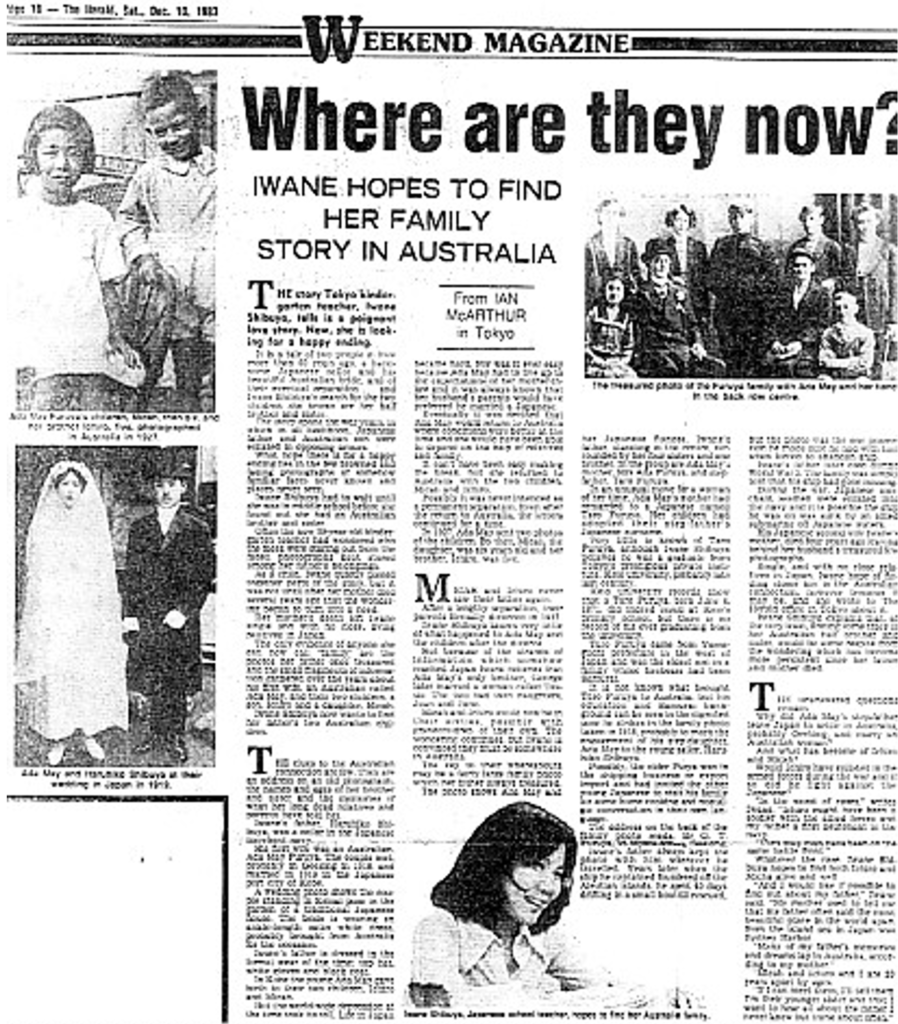
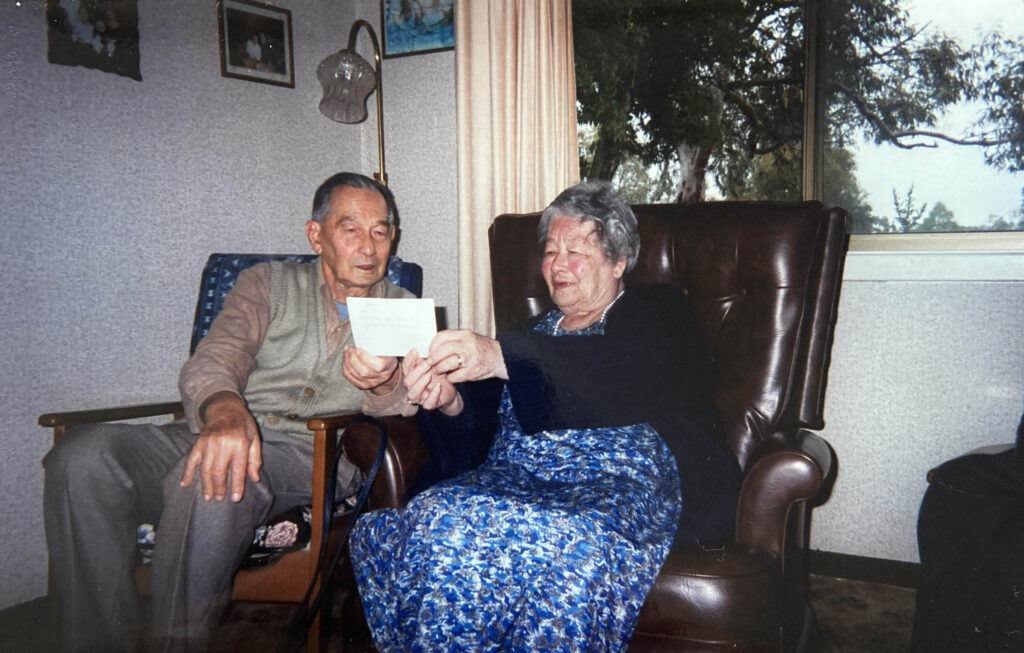
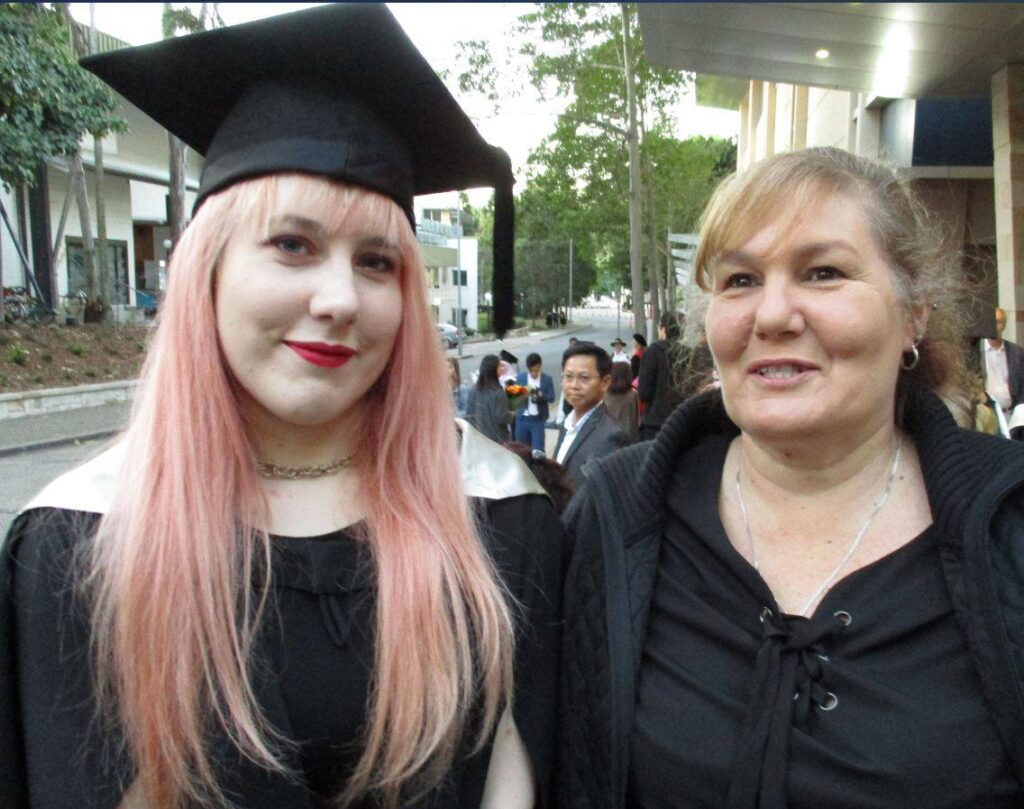
Trackbacks/Pingbacks